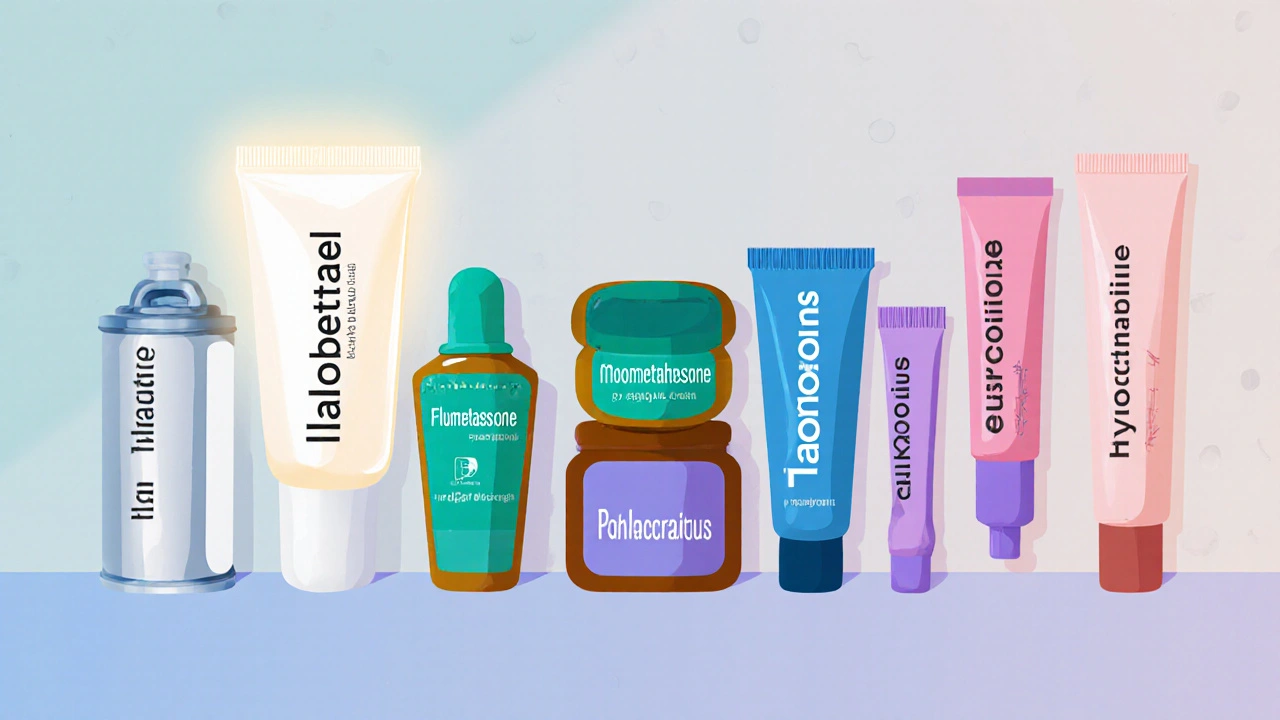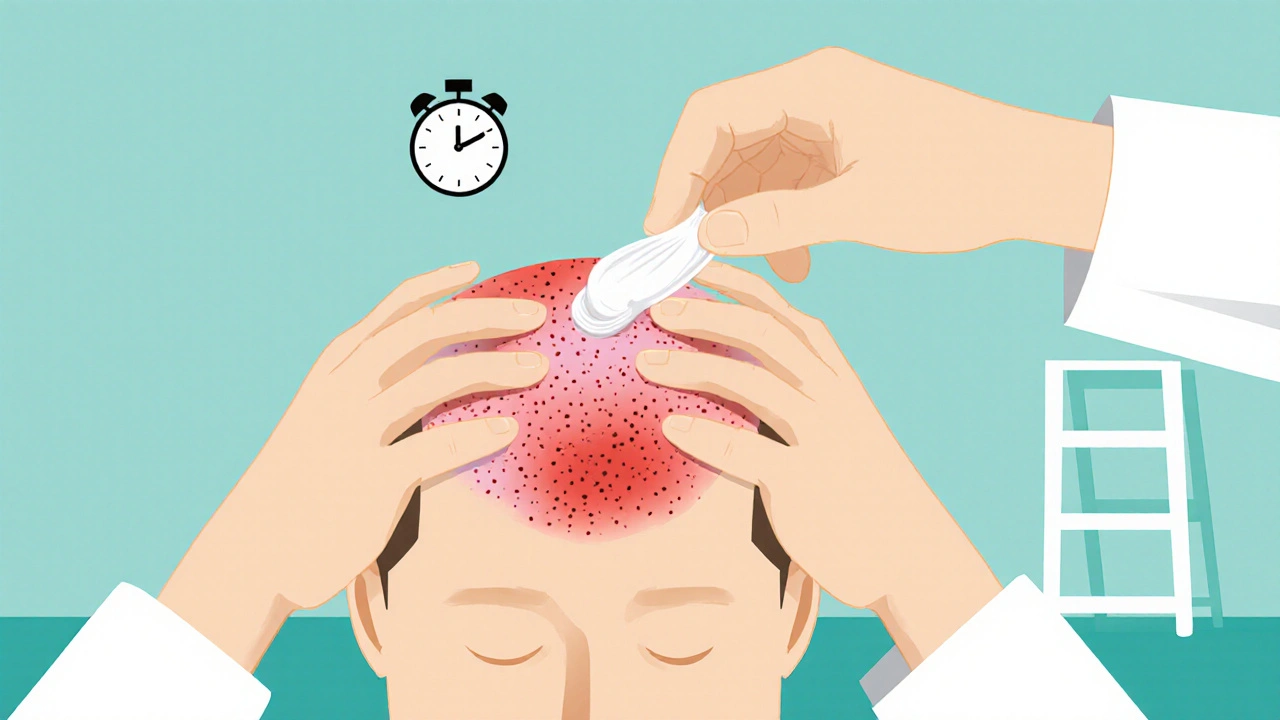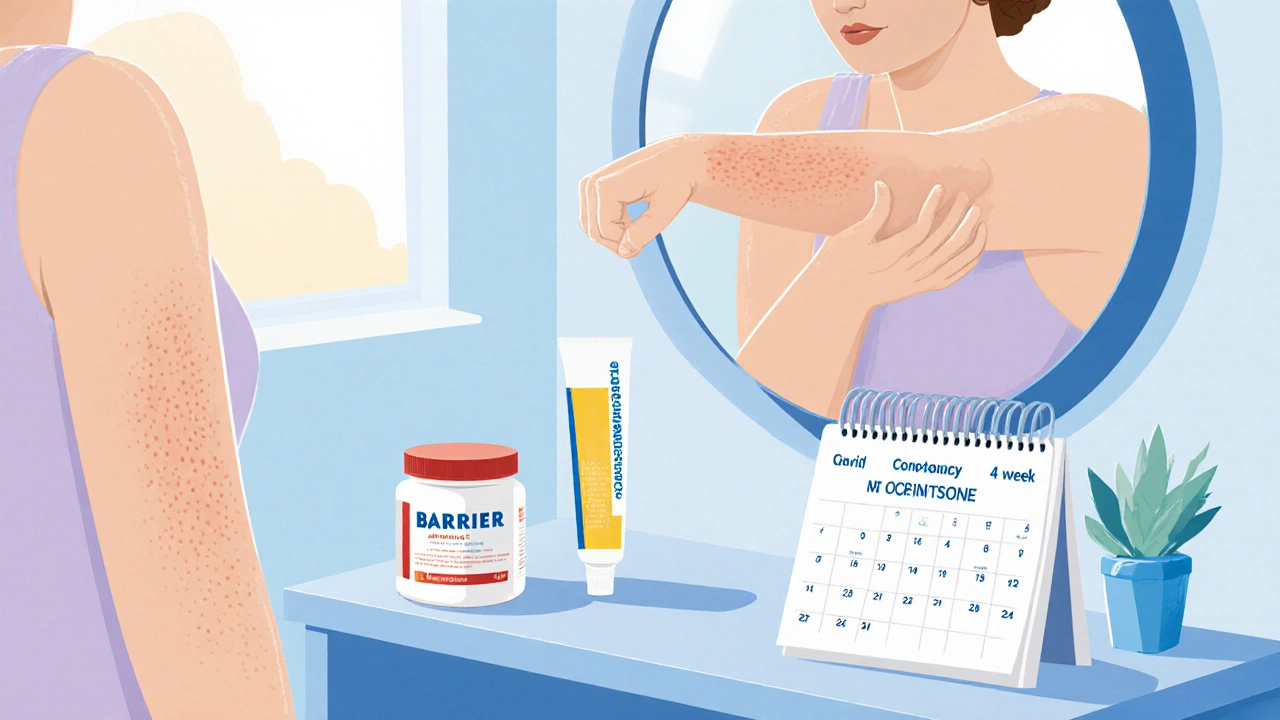Tenovate (Clobetasol Propionate) vs Topical Steroid Alternatives: Detailed Comparison

Topical Steroid Selection Tool
Find Your Best Topical Steroid Option
Select your condition and treatment parameters to get personalized recommendations based on medical evidence.
Select your treatment parameters to view personalized steroid recommendations.
Key Takeaways
- Tenovate (clobetasol propionate) is a class‑I super‑potent steroid with rapid relief for plaque psoriasis, discoid lupus, and severe eczema.
- Its main competitors-betamethasone dipropionate, halobetasol propionate, mometasone furoate, and fluocinonide-offer slightly lower potency or different vehicle formats.
- Non‑steroidal options such as tacrolimus or pimecrolimus work well for steroid‑sparing regimens but lack the instant anti‑inflammatory punch.
- Choosing the right alternative depends on potency, skin‑type, treatment‑area, duration of use, and risk of side‑effects.
- Follow a clear tapering plan and monitor for thinning skin, hypothalamic‑pituitary‑adrenal (HPA) suppression, and local irritation.
Understanding Tenovate (Clobetasol Propionate)
When treating stubborn skin conditions, Tenovate (Clobetasol Propionate) is a super‑potent class‑I topical corticosteroid that delivers strong anti‑inflammatory action. It comes in cream, ointment, and scalp‑solution forms, typically at 0.05 % concentration. The drug works by binding glucocorticoid receptors, suppressing cytokine release, and reducing epidermal hyperplasia. Because of its strength, clinicians reserve Tenovate for short‑term bursts-usually 2‑4 weeks-on limited body surface area (BSA) to avoid systemic absorption.
Key attributes:
- Potency: Class I (super‑potent)
- Typical dose: thin layer twice daily
- Onset of action: within 24 hours
- Common indications: plaque psoriasis, severe eczema, lichen planus, scalp disorders
- Major risks: skin atrophy, striae, telangiectasia, HPA‑axis suppression
How to Compare Topical Steroids
Not all steroids are created equal. To line up alternatives, consider these decision criteria:
- Potency level - Class I (very high) to Class VII (very low). Higher potency = faster relief but higher side‑effect risk.
- Vehicle - Cream, ointment, gel, foam, or solution. Ointments usually enhance penetration; gels are better for hairy areas.
- Indication match - Some formulations are approved for scalp, others for intertriginous zones.
- Duration of therapy - Short bursts for flare‑ups vs. maintenance regimens.
- Safety profile - Systemic absorption, skin‑thinning potential, contraindications.
- Cost & availability - Prescription only vs. over‑the‑counter (OTC) options.
Leading Prescription Alternatives
Below are the most frequently prescribed steroids that sit near Tenovate on the potency ladder.
Betamethasone Dipropionate
Class II (high‑potency) and available as cream, ointment, or lotion (0.05 %). It’s often the first step‑down after a brief Tenovate course. The drug reduces inflammation effectively while lowering the risk of skin atrophy compared with class‑I agents.
Halobetasol Propionate
Another class I steroid, but marketed primarily in foam (0.05 %). The foam spreads easily on the scalp and thick plaques, offering comparable potency to Tenovate with slightly better cosmetic acceptability.
Mometasone Furoate
Class II (mid‑high potency) in cream or ointment (0.1 %). It’s favored for facial and intertriginous areas because it’s gentler on delicate skin while still providing rapid symptom relief.
Fluocinonide
Class I (super‑potent) available as cream, ointment, or solution (0.05 %). It penetrates well, making it a solid choice for thick palm‑plantar psoriasis, but it shares Tenovate’s side‑effect caution.

Over‑the‑Counter and Steroid‑Sparing Options
When patients want to avoid prescription steroids or need a maintenance plan, these alternatives are worth mentioning.
Hydrocortisone (1 % or 2.5 %)
Class VII (very low potency) in cream or ointment. It’s safe for long‑term use on large BSA but only mildly reduces inflammation-useful for mild eczema or as a bridge after tapering stronger steroids.
Tacrolimus (0.1 % ointment)
Calcineurin inhibitor, non‑steroidal, approved for atopic dermatitis on the face and intertriginous zones. It doesn’t cause skin thinning, making it ideal for steroid‑sparing strategies, though it can sting initially.
Pimecrolimus (1 % cream)
Another calcineurin inhibitor suited for sensitive areas. Comparable efficacy to low‑potency steroids with a better safety profile for chronic use.
Side‑by‑Side Comparison Table
| Product | Class / Potency | Typical Concentration | Vehicle | Best Use Cases | Key Risks |
|---|---|---|---|---|---|
| Tenovate (Clobetasol Propionate) | Class I - Super‑potent | 0.05 % | Cream, Ointment, Scalp Solution | Severe plaque psoriasis, scalp disorders, lichen planus | Skin atrophy, HPA suppression, striae |
| Halobetasol Propionate | Class I | 0.05 % | Foam | Scalp psoriasis, thick plaques where foam spreads well | Similar to Tenovate; foam may cause irritation |
| Betamethasone Dipropionate | Class II - High | 0.05 % | Cream, Ointment, Lotion | Step‑down therapy, facial or flexural eczema | Lower atrophy risk than class I, still possible |
| Mometasone Furoate | Class II | 0.1 % | Cream, Ointment | Face, neck, intertriginous zones | Minimal thinning; caution on long‑term use |
| Fluocinonide | Class I | 0.05 % | Cream, Ointment, Solution | Palm‑plantar psoriasis, thick hyperkeratotic lesions | High atrophy risk; avoid on large BSA |
| Hydrocortisone (1 % or 2.5 %) | Class VII - Very low | 1 % / 2.5 % | Cream, Ointment | Mild eczema, as a maintenance after taper | Very low systemic risk; limited efficacy for severe disease |
| Tacrolimus 0.1 % Ointment | Non‑steroid | 0.1 % | Ointment | Atopic dermatitis on face/neck, steroid‑sparing | Initial burning sensation; rare lymphoma concern (theoretical) |
| Pimecrolimus 1 % Cream | Non‑steroid | 1 % | Cream | Sensitive‑area eczema, long‑term control | Similar to tacrolimus; cosmetic acceptability higher |
Practical Tips for Using Tenovate and Its Alternatives
- Apply a pea‑sized amount to the affected area; more does not mean faster relief.
- Limit use to 2‑4 weeks for class I agents unless a specialist advises otherwise.
- Use a barrier (e.g., petroleum jelly) on thin skin (e.g., eyelids) if a steroid is absolutely necessary. \n
- When stepping down, switch to a class II or III steroid for another 2‑4 weeks before moving to low‑potency or non‑steroidal agents.
- Monitor for signs of thinning: increased translucency, easy bruising, or stretch marks.

When to Avoid Tenovate
Because Tenovate is so potent, avoid it in these scenarios:
- Infants under 2 years of age (skin barrier too fragile).
- Large BSA coverage (>10 %).
- Facial, intertriginous, or genital skin unless a dermatologist specifically prescribes it.
- Active viral, fungal, or bacterial skin infections without concurrent antimicrobial therapy.
- Patients with known HPA‑axis disorders or uncontrolled diabetes.
FAQs - Tenovate vs. Alternatives
Is Tenovate stronger than halobetasol?
Both are class I steroids, so their intrinsic potency is comparable. The difference lies mainly in vehicle: Tenovate is a cream/ointment, while halobetasol is often a foam, which can feel lighter on the scalp.
Can I use a steroid‑sparing cream while on Tenovate?
Yes. Moisturizers or barrier repair creams can be applied after the steroid has absorbed (about 30 minutes). This helps reduce dryness and supports the skin’s barrier during treatment.
How long does it take for Tenovate to show results?
Most patients notice a reduction in redness and scaling within 24-48 hours. Full clearance of thick plaques may require 2-3 weeks of consistent use.
Is it safe to combine Tenovate with a calcineurin inhibitor?
Combining a potent steroid with tacrolimus or pimecrolimus is generally not recommended due to overlapping immunosuppressive effects. Use one or the other, or alternate under a dermatologist’s guidance.
What should I do if I notice skin thinning?
Stop the steroid immediately and switch to a low‑potency option like hydrocortisone 1 % or a non‑steroidal agent. Consult your dermatologist for a tapering plan and possible skin‑repair therapies.
Bottom Line
Tenovate’s unmatched potency makes it a go‑to for severe, localized flares, but its risks demand disciplined use. Alternatives such as betamethasone dipropionate or mometasone furoate provide a gentler power curve for maintenance, while calcineurin inhibitors give steroid‑free control for delicate zones. By weighing potency, vehicle, and safety, you can craft a treatment ladder that maximizes relief and minimizes harm.

Andrew Wilson
October 23, 2025 AT 22:28We can't just splash Tenovate on any rash like it's a miracle cream. Super‑potent class‑I steroids belong in a doctor’s toolbox, not in the bathroom cabinet of every over‑the‑counter shopper. Misusing it invites skin atrophy, striae, and even HPA‑axis suppression-serious side‑effects you won’t fix with a quick moisturizer. Stick to the recommended 2‑4‑week bursts and keep the treatment area small, otherwise you’re playing a risky game. Remember, potency without discipline is a recipe for disaster.
Kristin Violette
November 10, 2025 AT 06:08When constructing a therapeutic ladder for inflammatory dermatoses, the pharmacodynamic profile of clobetasol propionate warrants meticulous stratification. Its glucocorticoid receptor affinity, quantified in nanomolar ranges, surpasses that of betamethasone dipropionate, thereby dictating a more pronounced transcriptional repression of NF‑κB mediated cytokines. However, the pharmacokinetic variables, such as dermal penetration modulated by the vehicle matrix-cream versus ointment versus solution-introduce a layer of complexity that clinicians must calibrate against lesion morphology. For example, the occlusive nature of ointments enhances percutaneous absorption, which is advantageous for hyperkeratotic plaques but escalates systemic exposure risk if applied over extensive body surface area. Conversely, the scalp solution formulation offers a hydrophilic conduit that circumvents the stratum corneum barrier, making it optimal for seborrheic regions where follicular sebum can impede drug delivery. From a safety standpoint, the dose‑response curve is steep; a pea‑sized amount applied twice daily yields therapeutic concentrations without surpassing the threshold for iatrogenic adrenal suppression, provided the treatment duration does not exceed four weeks. Tapering protocols should incorporate a step‑down to class‑II agents such as mometasone furoate, leveraging its lower atrophogenic potential while maintaining anti‑inflammatory efficacy. Moreover, adjunctive barrier repair moisturizers applied after a 30‑minute absorption window can mitigate xerosis and preserve epidermal integrity, thereby reducing the propensity for rebound flares. In patients with comorbidities like diabetes mellitus or uncontrolled hypertension, the systemic glucocorticoid load, albeit minimal, may exacerbate glycemic variability; thus, close monitoring of fasting glucose levels is advisable during high‑potency bursts. The risk–benefit calculus also necessitates vigilance for opportunistic infections; while clobetasol does not possess intrinsic antimicrobial activity, its immunosuppressive action can unmask latent viral eruptions such as herpes simplex. Finally, health economics cannot be ignored-while tenovate is often priced higher than generic betamethasone, its rapid resolution of severe plaques may reduce ancillary costs associated with prolonged disease activity. Integrating these multidimensional considerations into a patient‑centric algorithm ensures that the unparalleled potency of Tenovate is harnessed responsibly, delivering maximal clinical benefit while safeguarding against avoidable adverse outcomes.
Theo Asase
November 27, 2025 AT 14:48It's no coincidence that Big Pharma pushes Tenovate as the go‑to super‑steroid while keeping the cheaper, safer alternatives under the radar. The lobbyists have engineered a narrative where only the most potent, highest‑risk molecules can "prove" their superiority, effectively binding us to a cycle of dependency and profit. Meanwhile, the regulatory agencies, compromised by industry funding, ignore the long‑term epidemiological data linking chronic class‑I steroid exposure to systemic complications. They dress it up as "necessary for severe cases," yet the marketing materials masquerade as unbiased science, subtly coercing physicians into prescribing without thorough risk disclosure. Remember, every time you reach for a foam or cream painted with a brand logo, you’re reinforcing a system that thrives on patient vulnerability, not on genuine therapeutic advancement.
Joey Yap
December 14, 2025 AT 23:28While it's understandable to be wary of industry influence, the clinical evidence still validates the targeted use of high‑potency steroids when other options have failed. Balancing efficacy with safety means adhering to strict application limits and monitoring, which can mitigate many of the concerns raised.